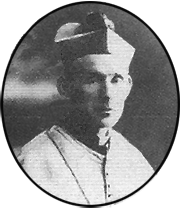View entry
Name: GOGARTY, Henry Aloysius (Rev. Father)

Birth Date: 9 Sep 1884 Cavan, Ireland
Death Date: 8 Dec 1931 Montana
First Date: 1922
Profession: R.C. Mission
Area: Mombasa
Author: In the Land of the Kikuyus, 1920; Kilimanjaro:an East African Vicariate, 1927
Book Reference: KAD, Red 25, Red 22, Medals
General Information:
Wikipedia: Bishop Henry Aloysius Gogarty C.S.Sp.., was an Irish priest in the Holy Ghost Fathers, who served in Eastern Africa, becoming a bishop. Born in Cavan, Ireland, on the 9th of September in 1884, Henry went to Rockwell College ,taking exams in the Royal University of Ireland, and joining the Holy Ghost order he went to the novitiate at Chevilly near Paris and was ordained at Paris in 1914 and was appointed to Zanzibar. In 1923 Dr Gogarty was appointed Vicar Apostolic to Kilimanjaro and titular bishop Themiscyra. He was ordained a bishop in 1924 in Cobh, Co. Cork. In 1927 he was responsible for the foundation of the Congregation of Our Lady of Kilimanjaro. The Rt. Rev. Gogarty was treated at the Montana Sanatorium of the Congregation for his tuberculosis. Bishop Gogarty returned in frail health to Montana, where he died on December 8, 1931.
Henry Gogarty Memorial Girls' Secondary School in Arusha, Tanzania is named in his honor.
Henry J. Koren, Spiritan East African Memorial, 1994: A student at Rockwell since 1897, he entered its junior seminary in 1900. After prefecting for two years at Rockwell, he made his vows on October 3, 1909 at Chevilly, did his senior studies there and was ordained a priest on October 28, 1913. As he desired, he was appointed to East Africa. The outbreak of World War One, however, delayed his departure for the Zanzibar vicariate till May 2, 1915. Bp Neville placed him in Nairobi, where five hospitals were filled with ailing, wounded or dying soldiers and civilians. The British government promptly gave him a captain's rank and made him a military chaplain. As such, he could freely circulate in both Kenya and the conquered parts of German East Africa. He came to admire the Kikuyu very much for their martial bearing, their will to work and their uprightness, and he spent much time with them. His devotion to the wounded soldiers became legendary among them.
In 1918 he contracted smallpox. He was repatriated in March 1919 via South Africa. Six months later, he could return to Kenya and took charge of the Mombasa mission. Then, in 1922 he became the Apostolic Administrator of the Kilimanjaro vicariate, whose Alsatian bishop had been expelled from the country at the end of the war. Times had changed. The new administrator rode all the way from Mombasa to Kilema on a motor cycle instead of coming by caravan. Trucks were rapidly replacing porters throughout the country and automobiles were increasingly becoming more common. Now a safari that used to take a week on foot could be made in a few hours. That motor cycle was a sign that the missions, too, should acquire motorized transportation. And they did. He set to work with a will and made the others also work "at top speed" to rebuild whatever had not yet been repaired and to expand operations. He was in a hurry, for he knew that he had tuberculosis.
In 1924 the Holy See named him Vicar Apostolic of Kilimanjaro, and he went home to Ireland to be ordained a bishop at Cobh on June 8 of that year. Then he went on a fund-raising tour in Ireland and England to replenish the depleted purse of the vicariate. Crossing over to Holland, he secured the return of the Precious Blood Sisters to East Africa. These valiant nuns had been expelled as enemy aliens during the war, but they were greatly admired as "the best Sisters I have travelled all over the Spiritan world. Going on to Switzerland, he spent a few months in the Montana sanatorium of the Congregation to take care of his tuberculosis and then went to the U.S.A. for more fund-raising. Six more months at Montana followed, but in 1926 he could return to Kilimanjaro. Meanwhile the St. James intervicarial seminary and the St. Patrick's Teacher Training School he had ordered had been built below Kilema and at Singa Chini, respectively. He became the driving force in the great expansion of the school system in his territory.
By 1930 there were about 340 teachers serving in the vicariate's school, who also doubled as catechists. By then there were 30,000 Catholics in his domain and the stage was set for the great influx of many more in the near future. It pained him to be so short of priests and unable to get more. They were to come soon, for American and Dutch Spiritans were poised to come, but he did not live to see their arrival in large numbers. In October 1931 his exceedingly frail health forced him to return to Montana. He died there a few weeks after his arrival, leaving the memory of a saintly life wholly dedicated to the service of his beloved Africans.
